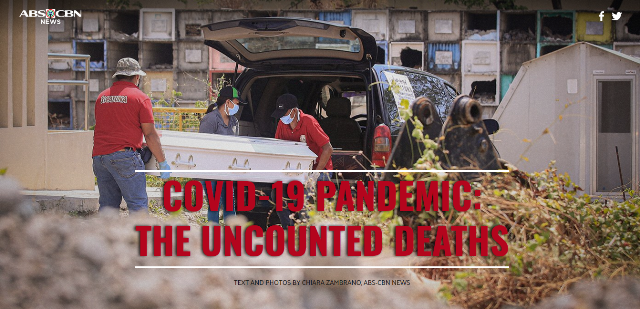Making the uncounted count: ABS-CBN looks beyond official COVID death toll

THE DEPARTMENT of Health updates the number of confirmed COVID-19 cases, as well as recoveries and deaths daily. Cases in the Philippines have breached the 15,000 mark and continue to increase. The rising number of infections naturally gets the most emphasis in news reports. Some groups have questioned the validity of this count, but DOH has not addressed this issue. Media have hardly discussed the recovery rate or the death count. At 942, the fatalities may be considered low. But is the number an accurate count?
A special report by news.ABS-CBN.com opened the discussion of deaths during the pandemic. Chiara Zambrano’s “COVID-19 Pandemic: The Uncounted Deaths” compiled interviews with physicians, local chief executives and civil registrars, backing these up with official mortality data from local and national levels that she presented in graphs.
She opened her report with the narration by Gerry Alcantara, a health worker whose brother, a diabetic, died, without anyone knowing for sure whether he was afflicted with COVID-19 or not.
From this personal story, Zambrano examined how different sources of information on COVID-19 deaths challenge the validity of DOH’s numbers, suggesting the unreliability of government’s official count and classification of cases and the under-reporting of deaths caused by the disease.
The report named the different factors, such as the strict reliance of the national government on laboratory-confirmed cases, inconsistent reporting mechanisms across institutions, and the under-appreciation of physicians’ individual, clinical judgments.
Some of the key points in the report:
- Local governments like Quezon City and Makati City are recording more “COVID-related” deaths than confirmed “COVID-positive” deaths. In both classifications, the average age of the casualties is 60 and the leading causes of death are respiratory and cardiovascular illnesses, particularly pneumonia. The only difference is that unlike the “COVID-positive” deaths, the “COVID-related” fatalities died without a definitive COVID-19 test result.
- At the level of the civil registrar, workforce and time constraints limit the staff to processing papers on the deaths. The City of Manila sticks only to what is written in the death certificates, without noting whether these could be “COVID-related.” This is different from the system used by Quezon City and Makati City. As a result, nearly all deaths reported from March 11 to April 10 were classified as “non-COVID related,” even as the casualties had the same respiratory and cardiovascular diseases noted by Quezon City and Makati City as “COVID-related.”
- Dr. Jonas del Rosario, spokesperson of the Philippine General Hospital, said more doctors are now erring on the side of caution, labeling a pneumonia patient as a “COVID-19 suspect” unless proven otherwise by a lab test. This is after the DOH decided to change the classification of patients from “persons under monitoring or investigation” to “suspect, probable or confirmed.” But the people who died untested prior to the re-classification won’t be included in the COVID-19 casualty count anymore, especially if their death certificates have already established they weren’t killed by the disease.
The findings invite further question: When is COVID-19 ruled out as the cause of death, especially for those who had pre-existing medical conditions or illnesses?
Zambrano closed her report by going back to her exchange with Alcantara, who learned eight days after her brother’s death that he did contract COVID-19. Alcantara checked the DOH tracker and found what resembles his brother’s profile in the list of cases for validation. She is still waiting for him to be included in the official death count, telling Zambrano, “It’s the grieving process. It’s really knowing with certainty why my loved one died.”
Indeed, the COVID-19 pandemic has affected the way people mourn their dead.
But the various accounts cited by Zambrano underscore the government’s failure to track the disease, and to count the deaths caused by COVID-19 as well as the COVID-related fatalities. A higher number would serve to warn the public about the continuing dangers of infection.
Quite possibly, media reports that repeat DOH figures perpetrate a misreading of the actual dangers of public exposure. Media need to look beyond official figures and point out gaps in existing mechanisms in order to understand the extent of the challenges posed by this disease.
Leave a Reply